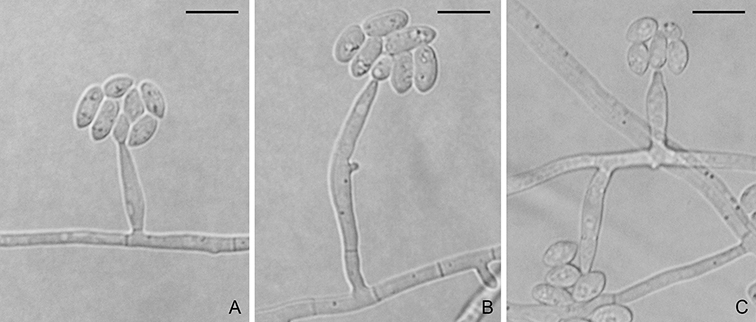
Figure. Magnaporthiopsis panicorum (CM2s8). A–C. Conidiophores and conidia. Scale bars: A–C = 10 µm.
Magnaporthiopsis panicorum J. Luo & N. Zhang.
MycoBank: MB807084.
Asexual state phialophora-like. On CMA, hyphae branched, septate, hyaline to light brown, smooth, 2–4.5 µm diam. Conidiophores micronematous, solitary, erect, straight or curved, unbranched or sparsely branched, hyaline, smooth. Conidiogenous cells phialidic, hyaline, straight or slightly curved, 5–30.5 × 2–3.5 µm. Conidia aggregated in slimy heads, ovoid, straight or slightly curved, aseptate, hyaline, smooth, 7.5–11.5 × 3.5–5 µm. Sexual state unknown.
Colonies on PDA 4.8 cm diam after 7 days at 25 °C in dark; surface floccose, parrot green; aerial mycelium yellowish; reverse cedar green. Colonies on CMA reaching 5.5 cm after 7 days in dark at 25 °C; surface pale yellow-green; aerial mycelium sparse; reverse pale yellow-green (Description from Luo et al., 2014).
Typification: Holotype RUTPPCM2s8. Ex-holotype culture CM2s8.
Gene sequences: KF689593 (18S), KF689643 (ITS), KF689633 (28S), KF689603 (MCM7), KF689613 (RPB1), KF689623 (TEF1).
Genome sequences: SRX798626 (transcriptome).
Specimens examined: USA, New Jersey, Colliers Mills, N40 04.093, W74 26.598, 42 m, from roots of Panicum, 30 Aug. 2012, J. Luo and N. Zhang, RUTPPCM2s8, RUTPPCM7m9, RUTPPCM9m11, RUTPPCM10s2.
Hosts/substrates: From roots of Panicum and other Poaceae.
Distribution: USA (New Jersey).
Copyright 2022 by The American Phytopathological Society. Reproduced, by permission, from Luo, J., and Zhang, N. 2022. The Rice Blast Fungus and Allied Species: A Monograph of the Fungal Order Magnaporthales (https://my.apsnet.org/APSStore/Product-Detail.aspx?WebsiteKey=2661527A-8D44-496C-A730-8CFEB6239BE7&iProductCode=46826). American Phytopathological Society, St. Paul, MN.